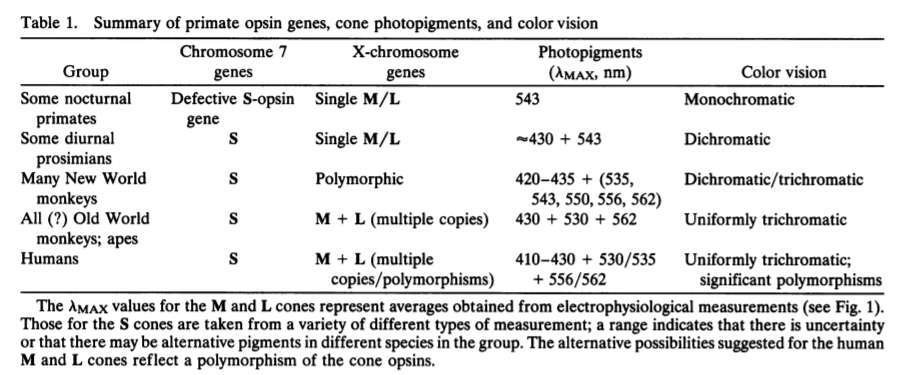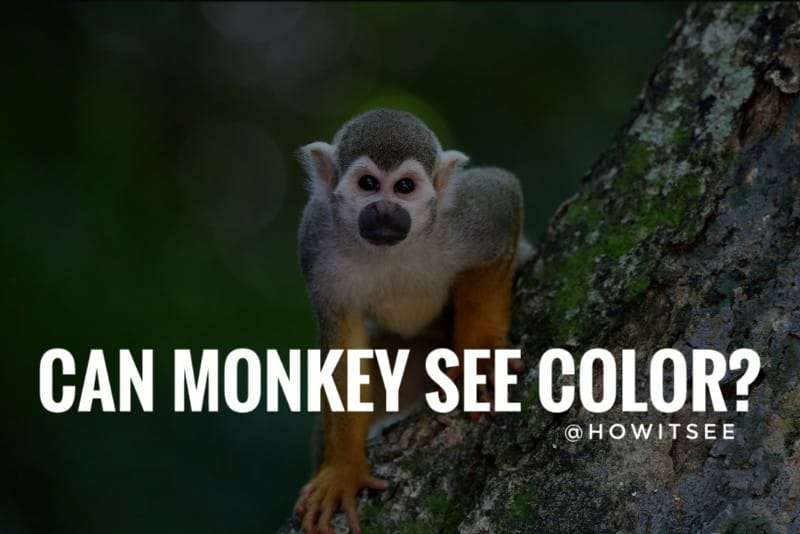Simians, or higher Primates, have been on the Earth since the Cenozoic era. They evolved and split into distinct families; New World monkeys, Old World monkeys, and apes (including humans). But has their vision evolved like us, or can they see all color shades like us?
The answer to the question, “Can Monkey see color” is: Old World monkeys like langur, chimpanzees can see all colors variations like humans. They have trichromatic vision. On the contrary, New World monkeys may be trichromatic or dichromatic, depending on their species. However, some exceptional ones, like owl monkeys, have the monochromatic vision.
Even in Monkeys, there are different groups, and apes are not categorized under them. Apes have all identical properties to humans, but in New World and Old World monkeys, there are some distinctions as mentioned above. Hence, in this post, we have explained the answer to many identical queries related to Monkey’s vision. So, let’s begin.
Can Monkeys see color?
Most Old World monkeys and apes are trichromatic and can see the visible spectrum. Trichromatic vision means the rod and cones in their eyes react to three colors, i.e., red, blue, and green.
However, Prosimians have a low color vision as they are dichromatic. On the other hand, New World monkeys have surprisingly variable color vision depending on their environment and groups.
Although many of them are trichromatic, some have dichromatic vision. It is observed that most of the females in the New World primates are trichromats, and on the other side, males can’t react to red color.
One common example is squirrel monkeys. Many squirrel monkeys have dichromatic vision.
Now jump to the monochromatic ones. Nocturnal owl monkeys and Greater Galagos have the absence of short-wavelength cones leading them to complete color blindness.
Even though these primates do have a single type of Middle/Large wavelength cone pigment, they are still unable to see color that assists them to see at night.
But Night owl monkeys have large eyes that comprise more rods, which are good for gathering light and sensing things in low light.

Source | pnas.org | Primate photopigments and primate color vision pdf (By John Dowling, Lubert Stryer (chair), and Torsten Wiesel)
Above, we have attached the image that distinguishes the color vision of different family groups of Primates. According to the image, some nocturnal monkeys have monochromatic color vision. It means they are color blind.
On the other side, some New World monkeys have dichromatic color vision. It means they can see only blue and green. And at last, many Old World monkeys and Apes have uniformly trichromatic vision meaning they can see millions of color variations. Kindly refer to the illustration below for a better understanding.

In conclusion, monkeys have excellent eyesight, and some of them have 1.1x of human vision. They can see colors and the world like us. However, their eyes mainly depend on their families/groups.
Can Monkeys see at Night or in the Dark?
No, like humans, monkeys or primates do not have the capability to see in the dark or at night. It is due to a lack of tapetum lucidum. Tapetum lucidum is a small film of reflective tissue present inside the eyes of many animals. It helps them to glimpse at night by reflecting even the slightest of light directly onto the retina.
However, some nocturnal monkeys, like owl monkeys, can see much better at night. They are monochromatic and have large eyes, which helps them perceive more light in the dark and catch grey-scale images. In exchange for color vision, they have evolved a better night vision.
According to the research, it is concluded that owl monkeys also lack tapetum lucidum, but they have something similar called collagenous tapetum fibrosum, which has a similar function and a central fovea.
In addition, their large eyes comprise more rods than cones that assist them in visually glimpsing even in the slightest of light.
Remember- Rods in the eyes help to perceive the light’s brightness and are responsible for seeing better in the low light condition. On the other hand, cones assist in recognizing the color shades and clarity.
Most monkeys are diurnal. They require color vision instead of night vision to identify their prey, navigate and carry out daily activities. Like us, they also complete their every task by the end of the day and safely sleep at night.

They usually avoid roaming in the forest in the dark. However, unlike humans, they are well aware of the dangers in the forest, and to sense them, they have sharp senses of smell and hearing. If anyone in the group sees the predator, it begins to shout and alerts everyone.
On the other hand, nocturnal owl monkeys are mostly active at night and carry out their daily activities in the dark. To achieve this, they are primarily dependent on their large eyes with collagenous tapetum fibrosum, a central fovea, and many rods. It provides them an ability to witness in the dark.
In conclusion, many monkeys have the same vision as humans. Therefore, like humans, monkeys cannot perceive images in the dark, except nocturnal owl monkeys.
Do Monkeys have color vision?
Maximum of the monkeys have the color vision; however, it primarily depends on their species.
Old World monkeys have trichromatic vision, which means they can see various colors. Trichromatic vision grants them the ability to perceive small, medium, and large wavelength colors from 380 nm to 720 nm.
Similarly, many New World monkeys can also see the visible spectrum and differentiate the millions of color shades like humans.
In contrast, some New World monkeys, like squirrel monkeys, have dichromatic vision. It means they can mostly see in blue and green. Due to the absence of the large wavelength cone, they glimpse the world in blue, pale yellow, and grey shades.
Apart from them, nocturnal monkeys have only one kind of cone and are colorblind. They don’t have color vision and see the world in shades of grey. They can sense the brightness of the light and the difference between the day and night.
Do Monkeys have Good Eyesight?
Yes, like humans, monkeys have very good eyesight. Their primary sensing ability is vision. They can see the world similarly to humans. However, their eyesight is mainly dependent on their groups.
- Nocturnal Owl Monkeys – Colorblind
- Squirrel Monkeys – Can only see blue and green
- Many other monkeys and apes – Have good eyesight and perceive millions of color variations.
Monkey vision vs Human vision
| Monkey Vision | Human Vision |
| Mainly depend on the families
Nocturnal Owl Monkeys – Monochromatic Squirrel Monkeys – Dichromatic Many other monkeys – Trichromatic |
Human Vision are trichromatic |
| Can see the visible spectrum | Can see the visible spectrum |
| Have good eye sight | Have good eye sight |
| Cannot see in the dark | Cannot see in the dark |
Here, we conclude our article on “Can Monkeys see color” or “what color do Monkeys see?” We hope this article provides some new information for the reader. We will be back with another post. Till then, stay tuned with us. Also, kindly advance to the references given below for in-depth information on this topic.
References
Primate photopigments and primate color vision (By John Dowling, Lubert Stryer (chair), and Torsten Wiesel).
Wikipedia
From day to night – a lesson in eye evolution with the owl monkey by National Geographic
PRIMATE COLOR VISION by palomar.edu
Also Read:

Meet Abhidept (nickname Monty), the visionary founder of How It See, being an engineering student, he’s fueled by an insatiable curiosity about the world around him. He is captivated by an eclectic correlation between animal groups, science, and nature, and this fascination drives his quest for understanding.
After completing his degree, he’s set on a mission to delve deep into the realm of nature, accumulating knowledge to share with you through his writing. In the meantime, he loves to watch anime and read anime.
